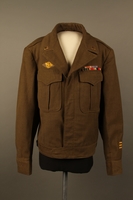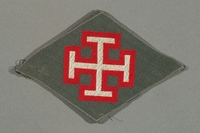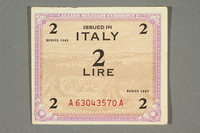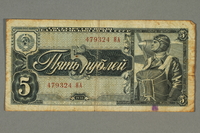Overview
- Brief Narrative
- Shield-shaped cloth patch - olive green with yellow bow and arrow emblem.
- Credit Line
- United States Holocaust Memorial Museum Collection, Gift of Richard Schifter
- Contributor
-
Richard Schifter
- Biography
-
Richard Schifter was born in Vienna, Austria on 31 July, 1923, the son of Paul (also known as Pinchas, 1886-1942?) and Balbina (née Blass, 1893-1942?) Schifter, both of whom were originally from Poland. Paul, who was from Stanisławow (modern day Ivano-Frankivsk, Ukraine), originally had citizenship in the Austro-Hungarian Empire, and Balbina, who was raised in a town near Warsaw, and later in Lublin, had citizenship in the Russian Empire. Following World War I the birthplaces of both of them were in the new Republic of Poland. They opted for Polish citizenship, but settled in Vienna.
Paul had apprenticed in a drugstore in Stanisławow, and around 1907 came to the United States and worked for a pharmaceutical firm in Rochester, New York. By 1913 he had saved sufficient funds to enable him to return to Stanisławow and purchase a drugstore. When World War I began, he was inducted into the Austro-Hungarian army, and served for the duration of the war with the pharmaceutical staff of various military hospitals, first in Hungary and later in Poland. When he was stationed in Lublin in 1916, he met Bajla (Balbina) Blass, whose parents had previously owned a farm near Warsaw prior to moving their family to Lublin. Paul and Balbina were married in a Hasidic ceremony in Lublin in 1919, and after they settled in Vienna, they repeated their vows in a temple in that city. By that time, Paul had sold his drugstore in Stanisławow and used the funds from that sale to purchase another one in Vienna, which he operated until he was forced to give it up, after the Nazi takeover of Austria in 1938.
On March 11, 1938, as Paul, Balbina, and Richard heard Austrian Chancellor Schuschnigg announce, on radio, his resignation and the Nazi assumption of power, they immediately decided to emigrate to the United States. Paul promptly wrote to an uncle in New York, Harry Brettholz, seeking affidavits. Because of the family’s limited means, and since Paul and Balbina were both natives of Poland, and had to wait on a much longer quota list to qualify for a U.S. immigrant visa, they decided to send their Austrian-born son, who qualified for a visa on the German quota, first. Meanwhile, in late October 1938—on the day of their wedding anniversary, it turned out—both parents were arrested due to their former Polish citizenship (of which the Polish government had deprived them). Before they were released one day later they were ordered to emigrate promptly. The family witnessed the events of Kristallnacht, and continued their efforts to leave the country. Richard travelled to Rotterdam, and from there left for New York on a ship of the Holland-America Line in December 1938, while his parents were smuggled into Poland in the spring of 1939, intending only to stay there for as long as it took to receive their visas to travel to the United States. Paul went to live with relatives in Stanisławow, and Balbina did the same in Warsaw, so that when war broke out in September 1939, and the Germans and Soviets invaded Poland, they were separated, with Paul living in Soviet-occupied territory, and Balbina in the German-occupied area. In 1940, Balbina moved to Lublin, and Paul to Lwów. Richard, by that time living in New York, maintained contact with his parents until the United States entered the War in December 1941. The last letter he received from them through the International Red Cross, dated July 1942, showed that Paul had joined Balbina in Lublin, and were in a ghetto in Maidan-Tatarski. After the war, Richard surmised that his parents had likely been killed during the liquidation of that ghetto in November 1942.
After arriving in New York in December 1938, Richard lived with relatives, primarily the family of his father’s aunt and uncle, Sophie and Harry Brettholz, in the Bronx. He attended DeWitt Clinton High School, and after graduating from there, enrolled in City College of New York, hoping to obtain enough education to apply for a civil service job with the Federal government in Washington, DC, which led him to study economics. Upon graduating in the spring of 1943, he was inducted into the U.S. Army, being sent first to Camp Fannin in Texas for infantry basic training. In October 1943, he was assigned to the Army Specialized Training Program (ASTP), and sent to Stanford University, to train for the planned occupation of the Dutch East Indies (Indonesia), with linguistic and other training. It was during that time that he received his U.S. citizenship. In early 1944, he was among those German-speaking soldiers who, as the Army prepared for the landing in France, were assigned to Camp Ritchie, Maryland, in order to be trained in military intelligence, including techniques for the interrogation of captured German soldiers. He deployed to the European Theater in July 1944, arriving first in England and then in France, in August 1944. Beginning in October 1944 he was stationed in Aachen, Germany, and charged with interviewing German civilians, work that led to one of the first studies of everyday life during the Third Reich. Following the end of the war, he was discharged from the Army, but remained in Germany as a civilian employee of the U.S. military government until 1948.
Upon returning to the United States, he enrolled in Yale Law School, earning an LL.B. degree in 1951, after which he joined the law firm of Riegelman, Strasser, Schwarz and Spiegelberg, in Washington, DC, with whom he worked as an attorney in the following decades. He served as Washington counsel for the Oglala Sioux Tribe of South Dakota, the Pueblo of Laguna of New Mexico, the Nez Pere Tribe of Idaho, and the Metlakatla Indian Community of Alaska and became a specialist in Federal Indian law, serving on the Presidents Task Force on American Indians in 1966-1967. From 1959 to 1979 he served on the Maryland State Board of Education, from 1975 onward as its President., During the administration of President Ronald Reagan, he was appointed U.S. Representative to the United Nations Commission on Human Rights (1983-1986), and Deputy U.S. Representative to the United Nations Security Council (1984-1985), after which he was nominated and appointed as Assistant Secretary of State for Human Rights and Humanitarian Affairs, a post in which he served from 1985-1992. President Bill Clinton appointed him as a Special Assistant to the U.S. National Security Council in 1993, where he served in that capacity until 1997, followed by service as Special Assistant to the Secretary of State from 1997 to 2001. Since 2005 he has been Chairman of the Board o Directors of the American Jewish International Relations Institute, AJIRI.
Physical Details
- Classification
-
Identifying Artifacts
- Category
-
Badges
- Object Type
-
Scout badges (ushmm)
- Physical Description
- Shield-shaped cloth patch - olive green with yellow bow and arrow emblem.
- Dimensions
- overall: Height: 2.500 inches (6.35 cm) | Width: 2.000 inches (5.08 cm)
- Materials
- overall : cloth, thread
Rights & Restrictions
- Conditions on Access
- No restrictions on access
- Conditions on Use
- No restrictions on use
Administrative Notes
- Legal Status
- Permanent Collection
- Provenance
- The patch was donated to the United States Holocaust Memorial Museum in 2016 by Richard Schifter.
- Record last modified:
- 2023-09-06 12:17:20
- This page:
- https://collections.ushmm.org/search/catalog/irn561866
Also in Richard Schifter collection
Correspondence, postcards, photographs, pins, patches, medallions, notebooks, and related documents and ephemera, related to the history of the Schifter family of Vienna, Austria, and the immigration of Richard Schifter to the United States in 1938 and his subsequent service in the U.S. Army during World War II. Includes family photographs, postcards and correspondence from Paul Schifter during his service in the Austrian Army during World War I, documents related to Paul Schifter's business ventures in the United States during the 1920s, school documents for Richard Schifter in Austria and the United States, documents from Richard Schifter's military service, correspondence from friends and family, including correspondence sent to Schifter by his parents after his emigration from Austria, 1938-1941; and related materials. Also includes Schifter's uniform jacket from the U.S. Army, and an album that belonged to his mother, containing photographs and postcards that had been sent to her.
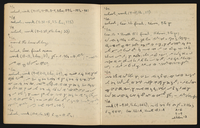
Richard Schifter family papers
Document
The Richard Schifter family papers consist of correspondence, documents, printed material, and photographs, related to the lives of the family of Richard Schifter and his parents, Paul and Balbina Schifter, in pre-World War II Austria, Richard’s immigration to the United States in 1938, his subsequent education and service in the U.S. Army during World War II, his parents’ deportation to Poland, and Richard Schifter’s unsuccessful attempts to help his parents in Nazi-occupied Poland. The Biographical series of documents largely relates to the immigration of Richard Schifter, and his adaptation to life in the United States and his military service. Included are files related to his education, including records, notes, and correspondence from both his schooling in Austria, and his high school and college years in New York. Among the Austrian documents are dictation exercises in English, including the translation of a speech by Austrian chancellor Kurt Schuschnigg in 1938. The American education records include correspondence with faculty at City College of New York, including a research paper wrote critical of an Austrian anti-Semitic writer. The diary from this period (1940-1943) is written largely in shorthand, which one of his professors encouraged him to learn, but does record events such as his reaction to the bombing of Pearl Harbor. The bulk of the biographical material relates to Schifter’s career in the U.S. Army, both while in training at Stanford University, but primarily during his years in training and service as a “Ritchie Boy,” as well as his post-war service. Related to the latter are documents pertaining to his wedding to Lieselotte Krüger in 1948, since approval had to be sought from military authorities for him to marry a German national. Also included is a file of correspondence sent in his military, including a letter to a U.S. Senator regarding conditions in the Army, a letter to an academic referring to proposals regarding the re-education of Germans after the war, and an exchange of letters with the American Jewish Joint Distribution Committee, following a visit Schifter had made to former concentration camp inmates at Mittelbau-Dora. A small amount of the Biographical series also contains material from Schifter’s father, Paul, chiefly related to the latter’s stay in the United States from 1910-1911, when he worked in Rochester, New York. The Correspondence series contains correspondence to Schifter from his parents, as well as correspondence with a number of people in the United States who he turned to for help in assisting his parents, both in efforts to send clothes and other material aid to them in Poland, as well as in seeking ways to help them immigrate. Among the latter, Mr. Jungwirth from Rochester, who apparently was acquainted with Paul Schifter from his time in the United States, sought to facilitate contact with Schifter’s parents in Poland and with others who had news of them. Correspondence from others includes friends and relatives—some identified only by first names—with whom he exchanged impressions of life in the United States, news about his parents, and news from Austrian friends who had emigrated. Many of the letters consist of carbon-copies of Richard Schifter’s outgoing correspondence, which he retained. The Photograph and Postcards series consists largely of pre-war images of Schifter’s immediate family, photographs of his parents and their families from the early 1900s (circa 1910-1920), including those found in one card album, and images Schifter saved from his service in the U.S. Army, primarily during his time in Europe, circa 1944-1945. In addition to the photographs, there are several folders of postcards that were sent or received by members of Schifter’s family, including those sent and received by his father during World War I, when Paul Schifter was in the Austro-Hungarian army.
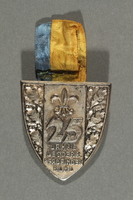
Scouting medal
Object
Austrian scouting medal (25 years - Osterreichischer Pfadfinderbund) in a shield shape, with blue and yellow ribbon attached. The badge also features a fleur de lis.

Scout patch
Object
Austrian scouting patch (Osterreichischer Pfadfinderbund) with white lettering on a red background, with a white stripe in the center with a fleur de lis.



